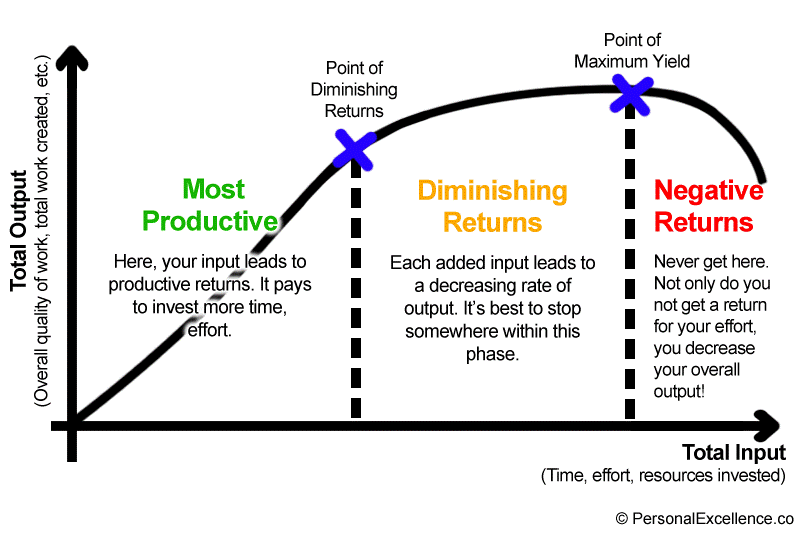
The Law of Diminishing Returns is an economic principle that describes the eventual decline in output associated with increasing investments into a product or service. If I have a factory that produces widgets for example, I can hire more people and produce more widgets. The first 10 people I hire might greatly increase productivity. But as I keep adding more people to the roster, the increases in productivity begin to go down (“diminishing returns.”) Production becomes limited by other factors such as machine time in the factory, or the number of widget tools that I have to go around. If I keep hiring more and more people, eventually they start getting in everyone’s way and productivity can actually begin to decline (“negative returns.”)
The Law of Diminishing Returns can also be applied to efforts of self-improvement. When a sedentary individual starts going to the gym, they will quickly see results from almost any effort that they put into exercising. But as they spend more time in the gym, the marginal increases in fitness will begin to get smaller and smaller. They will need to increase the duration, the frequency or the intensity of their workouts to get the same improvements that they saw when they were starting out.
The Law of Diminishing Returns is what makes it so difficult to achieve mastery in anything. It’s like climbing a hill that gets steeper and steeper the higher you go. This can be very frustrating and it’s why people often lose motivation for their New Years’ resolutions over time. The first few weeks of a new diet, a new exercise program or a new wellness ritual are very exciting and the results can be immediate and impactful. But as the incremental improvements begin to diminish, the motivation gradually fades away, and with it any hope of achieving the goals.
The Law of Diminishing Returns sounds like a rotten deal, and in some ways it is. But we can also think about the corresponding Law of Maximal Returns. We can focus on developing new skills and take advantage of the period of maximal returns that occur at the beginning of the curve. In other words, the best way to enhance your overall well-being, to develop new skills, or to evolve as a human being is to focus on areas where you haven’t already invested a lot of time and energy.
Taking up a new sport, a new hobby, or a new wellness practice allows you to slide right into the area of maximal returns. By exposing yourself to new experiences you maximize your potential for learning and growth and experience the biggest changes possible. Spending a couple of hours a week on something new, you could easily learn to meditate, to juggle, to paint or to play tennis. Spending that time in pursuit of greater mastery of a skill you already have might not yield the same results. It is far easier to go from being a non-tennis player to being a beginning tennis player than it is to go from being a good player to being a great player.
To continue leveraging the Law of Maximal Returns, you eventually need to move on from these new skills or hobbies as the returns begin to diminish. It is the “jack-of-all-trades” approach to learning. You constantly learn a little about a lot of things, rather than learning lot about a few things.
Another benefit to this approach is the development of “talent stacks,” an idea I learned from Scott Adams (of Dilbert fame.) A talent stack is (as it sounds) a stack of talents that work well together. People tend to focus on achieving success by being “great” at certain things. But you can also be successful by combining a collection of skills (even skills that you are only “good” or “mediocre” at) in a unique way. According to Adams, it was Donald Trump’s talent stack that got him elected. “Trump is a collection of good-but-not-special skills that sum up to something powerful.” Trump may not be “great” at certain things. But he is “good enough” in many things that combine together to make him very persuasive.
Some people won’t like the way this sounds, because we tend to glorify mastery. We admire the paragons of success who have sacrificed their development in many areas of their life in exchange for mastery in a single domain. Tiger Woods, Mike Tyson, Robin Williams and Vincent Van Gogh are all examples who achieved this mastery, but with huge opportunity costs in other areas of their lives. It may be that true wellbeing comes not from excelling in a single dimension, but from the total growth and learning one experiences over the course of their life. Following the Law of Maximal Returns, this growth is best achieved not by attaining mastery, but by continually developing new skills in a broad range of subjects.
by Jeremy McCarthy
Connect with me on facebook, twitter, or pinterest.
Image courtesy of Celestine Chua: https://personalexcellence.co/blog/law-of-diminishing-returns/

Companies need to understand that they’ve a allowing
employees to truly have a living outside of
work.
Fantastic article, will save and reference in future works I do (with full acknowledgement of course, and permission if necessary!)